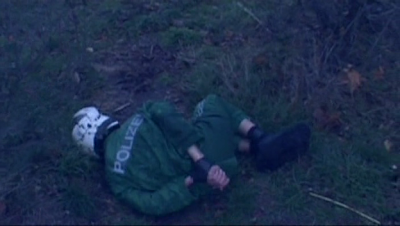Arguably, the most fundamental distinction between Marxism and Fascism, especially of the post-WWII blend, is that while the latter is a mostly a male-lead and masculine movement that espouses honor, taking pride in one's work, and a master mentality, the former is an innately effeminate political persuasion that sees work as the height of human degradation, worships the weak majority over the superior minority, is rooted in jealousy and a need for vengeance against the successful (the Marxist messiah himself, Karl Marx, was a failed bourgeois who never worked a day in his life and lived off the generosity of others, including Engels), promotes equality (i.e. collective mediocrity) and a decided disdain for the patriarch, so it should be no surprise that women were prominent in the Red Army Faction, among countless other far-left groups before and after them, and the case is no different for The Raspberry Reich; a film about a commie cuntress who leads her biologically 'male' cuckold compatriots into sucking cock against capitalism. Led by a less than ladylike egomaniacal gyno-supremacist Gudrun (Susanne Sachße) – a rather warped and wacky bitch suffering from sort of acute nympho-nihilism who justifies her all-consuming moral corruption and childishly contrived criminality by spouting absurd pan-sexual-neo-marxist slogans like "Out of the bedrooms into the streets!" (while engaging in sex in front of elderly people in a public elevator) and "Heterosexuality is the opiate of the masses" (when trying to force her heterosexual male comrades, including her suffering boyfriend, into cum-guzzling) – the so-called "Sixth Generation of the Baader-Meinhof Gang" aka “The Raspberry Reich” haphazardly plots to kidnap the son of a rich wealthy industrial named Patrick (Andreas Rupprecht); a recently out-of-the-closet sodomite who supremely sucks at skateboarding and likes to suck cock. After forcing her boyfriend Holger (Daniel Bätscher) to fuck his friend Che (Daniel Fettig) – a chronic masturbator who gets off to skimasks, handguns, and images of Che Guevara – Gudrun has her seemingly braindead band of terrorist underlings capture poof Patrick and, to the delight of the dick-loving hostage, perform homosexual acts on him so as to join the "The Homosexual Intifada". Little does everyone know that Clyde (Anton Z. Risan) – the weakest twin in the sexually subversive Sixth Generation – has already started a butt-pirate bond with Patrick. When it is revealed to the female Führer of flaming firebrand fag-scism that Patrick is a poofter partisan who agrees with the terrorist group’s perverted political ideology, Gudrun declares him the Raspberry Reich’s “Patty Hearst” and a “prisoner of love,” which he happily accepts as a faggy fan of force-entry fornicating. Although originally intending to send Patty boy’s fag-bashing father a video of his sperm burper son being sodomized by the turd-burglar terrorist so as to obtain ransom money, the revolutionary plans go awfully awry when love, betrayal, and megalomania get in the way of things. Ultimately, the intemperate terrorists become victims of their own political dogma due to their full-force fanaticism for flesh and dicks becoming bigger than petty politics.
Citing Serbian auteur Dušan Makavejev’s W.R.: Mysteries of the Organism (1971) – a work the Canadian director once claimed he “literally stole entire scenes from” – as the primary cinematic influence for The Raspberry Reich, Bruce LaBruce proved he was able to turn an esoteric Reichian/anti-Stalinist Slavic work into a MTV-esque porn flick of the aesthetically crappy kraut sort, which is certainly not a small ‘accomplishment,’ if you can call it that. Whereas in German New Wave auteur Rainer Werner Fassbinder’s The Third Generation (1979) – an absurdist work the director described as satirizing the third generation (following the ‘68ers and the Badder-Meinhof Group) of commie terrorism in West Germany, “which simply acts without thinking, which has neither a policy nor an ideology and which, certainly without realizing it, lets itself be manipulated by others, like a bunch of puppets” – LaBruce’s The Raspberry Reich depicts a degenerate establishment of so-called anti-establishment terrorists that has been spoon-fed since birth played-out leftist political swill taught to them in public schools and universities, thereupon being the very thing they claim to hate; mindless automatons who ultimately champion crude theoretical caricatures of relatively mainstream ideas, hence why Gudrun ends up a bourgeois mother after all, even if she continues to rape the minds of passive individuals by regurgitating sterile political statistics via her infant child. After all, what is more trendy today among college students than being effete feminist, cultural Marxist cock-suckers whose idea of liberation is fucking as many people as possible, especially members of the same sex and/or of a different race (the darker the better), getting abortions on demand, dressing like sexually confounded prostitutes, quoting Jewish and other non-white leftist authors, and donating corporate-earned cash to dubious non-profit organizations like the SPLC and ACLU? Indeed, the would-be-radical-revolutionaries in The Raspberry Reich cannot even make enough money to feed themselves, let alone spark a global revolution, hence why they hypocritically rationalize stealing from private proletarian-owned grocery stores, despite having plenty of time to swipe STD-contaminated fluids and adorn their walls with communist corporate icons like Angela Davis, Gudrun Ensslin, Ulrike Meinhof, Andreas Baader, and Che Guevara. Ironically, Jürgen Brünning – the self-described Marcuse-inspired producer of The Raspberry Reich – lost a court case against the daughter of Alberto Korda, photographer of the famous Ché Guevara portrait, thereupon causing a ban of screening the film by a Paris court, on top of the producer having to pay a fine of 17500 Euros because of “copyright and trademark issues.” Needless to say Marxism has been dying a slow and deserved death for some time now and The Raspberry Reich – a work that is just as much of a product of the anti-Occidental far-left Weltanschauung it superlatively satirizes – makes for an audacious allegorical digital-video epitaph of the debauched dick-devouring sort that is guaranteed to aesthetically nauseate individuals from all ends of the political spectrum.










































